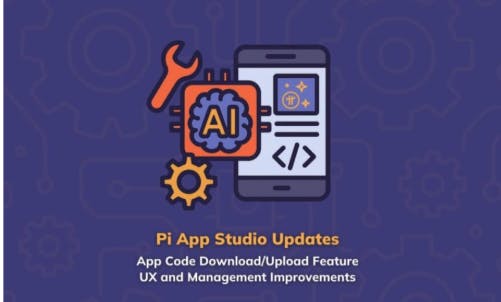Pi App Studio has introduced an update that shifts the platform from a purely no-code tool toward a more flexible development environment. The latest release adds support for downloading and uploading app source code, along with a set of usability improvements. For a platform known for helping non-technical creators build apps without writing code, the move signals a gradual broadening of its purpose within the Pi ecosystem.
Pi App Studio has long served creators who want to publish apps without navigating traditional development workflows. Its AI-assisted design process and easy deployment made it an entry point for people new to app building. The new code portability feature does not replace this path. It adds an optional track for those who want deeper customization or prefer working in their usual coding environments. By enabling users to export the code generated inside the studio, make changes locally, and re-upload the modified version, the platform starts to function as both a no-code builder and a foundation for more advanced development work.
Code Portability Opens a Hybrid Workflow
The new download and upload capability may be most notable for how it supports collaboration across skill levels. A creator can build the initial structure of an app in Pi App Studio, export the resulting codebase, and share it with a technical collaborator. That collaborator can refine features, adjust interface elements, or add more complex logic outside the studio. Once updated, the creator can bring the project back into Pi App Studio and continue working with the no-code tools they are comfortable with.
This workflow expands how teams can operate. Instead of choosing between no-code tools or full code environments, they can move between both. The approach may help early-stage projects move faster, since initial prototypes can be assembled quickly and then extended without discarding earlier work.
The feature also offers value to individuals who are learning to code. A creator might start with visual tools, then explore the exported files to understand how their app is structured. Over time, this can create a natural bridge between no-code experimentation and traditional development.
Developers Gain a Faster On-Ramp to the Pi Ecosystem
While the update benefits non-technical creators, it also changes how developers can use the platform. Pi App Studio can serve as a rapid way to produce a functional prototype, complete with Pi integration and deployment scaffolding. Developers can then export the code to continue work in their preferred editors, frameworks, or toolchains. This lets them bypass early configuration steps and focus on shaping the parts of the product that matter most.
The process also works in reverse. Developers who already have code for an application that meets the studio’s compatibility requirements can upload their existing project into the platform. Once inside, they can use the studio’s deployment and integration features to simplify the final stages of publishing a Pi-compatible app. This positions Pi App Studio as a utility layer that reduces friction for developers who want to engage with the Pi ecosystem without committing to a separate set of infrastructure tasks.
Interface Updates Aim to Improve Daily Use
Alongside the code-related changes, Pi App Studio has introduced updates that focus on daily usability. These include a reorganized management interface, additional options for handling apps, and improvements to the “My Apps” page. While these adjustments are incremental, they support users who manage several projects or iterate frequently. The updates may also reduce the learning curve for new creators, since navigation and app organization are now more consistent.
The Platform Moves Toward a More Flexible Future
This shift does not turn Pi App Studio into a full integrated development environment. The platform still operates within the constraints of the Pi ecosystem and retains its emphasis on simplified creation. However, the introduction of code portability adds room for nuance. Creators can shape app functionality more precisely, and developers can use the studio as a foundation rather than a limitation.
As these features evolve, Pi App Studio is becoming a more adaptable tool for people at different stages of skill and experience. The result is a platform that supports quick experimentation, encourages collaboration, and lowers the barriers to building more customized apps for the Pi ecosystem.


